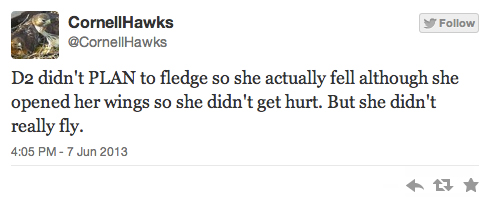Out at the Red-tailed Hawk nest the Cornell Lab of Ornithology documents with live video, viewers got a look at a harrowing accidental fledge by one of the three nestlings.
The video above shows the little hawk known as D2 take a slip right at the edge of the nesting platform. She then hangs — upside-down — by what seems like a single talon until she finally begins to flap and makes her way to the ground.
The episode left many viewers concerned about her well being, so Cornell Nestcam Moderator Laura Culley offered an excellent explanation of the situation in the series of tweets below.
Fledging is a dangerous time for the little hawks, and it’s stressful to watch. Culley’s calm, informed explanation is a good reminder that in most cases, the birds won’t need our help.
D2 didn’t PLAN to fledge so she actually fell although she opened her wings so she didn’t get hurt. But she didn’t really fly.
— CornellHawks (@CornellHawks) June 7, 2013
Now she’s in a foreign landscape, not really sure what to do and she had to deal with a lot of humans up in her face which was scary.
— CornellHawks (@CornellHawks) June 7, 2013
Then she had to work her way out of the lilac bushes and that was not easy. For a while, she was literally swimming on top of the lilacs.
— CornellHawks (@CornellHawks) June 7, 2013
Add to that the fact that it rained yesterday, making her feathers heavy and wet.
— CornellHawks (@CornellHawks) June 7, 2013
All that means, to escape the bushes, she had to use muscles that hadn’t been used that strenuously before so they probably hurt today.
— CornellHawks (@CornellHawks) June 7, 2013
So, like any normal critter, she’s just resting today, not pushing herself. And right now, there’s no danger and no REASON to push herself.
— CornellHawks (@CornellHawks) June 7, 2013
When she’s ready and feeling strong, she’ll make her move.
— CornellHawks (@CornellHawks) June 7, 2013
She’d be wailing up a storm if she were hungry (trust me on this!) and she’s not.She’s quiet and calm.
— CornellHawks (@CornellHawks) June 7, 2013
What’s happening isn’t ideal, but it’s not that unusual either. The most dangerous time of fledging is immediately after they leave the nest
— CornellHawks (@CornellHawks) June 7, 2013
So, at this time, there’s no need to worry, no need to intervene. Just wait and watch and be PATIENT!
— CornellHawks (@CornellHawks) June 7, 2013
